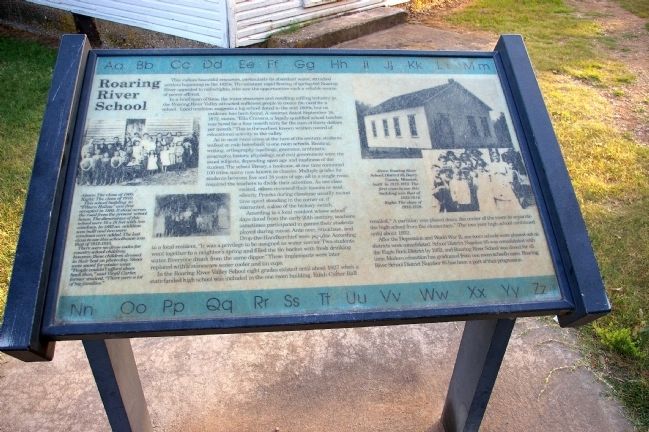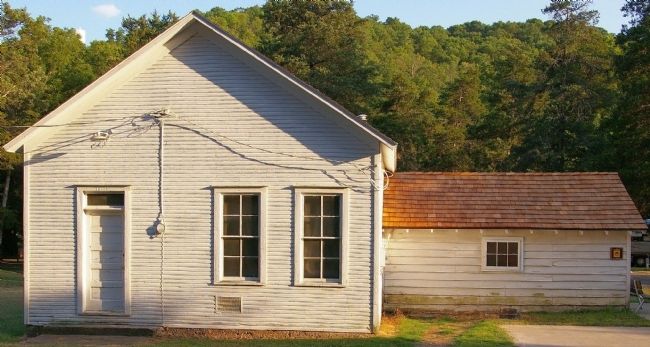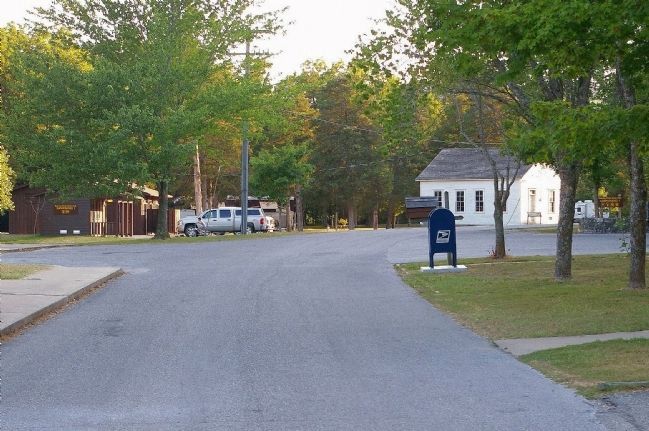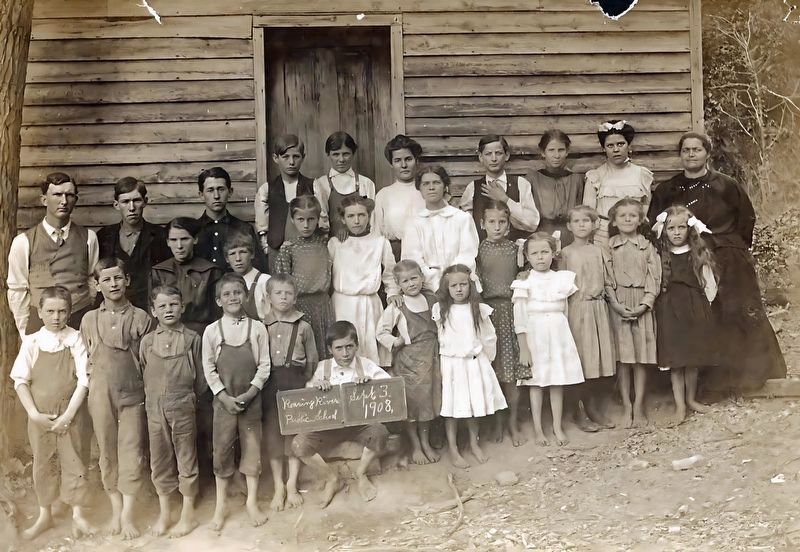Near Hilltop in Barry County, Missouri — The American Midwest (Upper Plains)
Roaring River School
In a brief span of time, the water resources and resulting milling industry in the Roaring River Valley attracted sufficient people to create the need for a school. Local tradition suggests a log school dated to the mid 1800s, but no evidence has been found. A contract dated September 16, 1872, states, "Ella Cravens, a legally qualified school teacher, was hired for a four month term for the sum of thirty dollars per month." This is the earliest known written records of educational activity in the valley.
As in most rural areas at the turn of the century, students walked or rode horseback to one room schools. Reading, writing, orthography (spelling), grammar, arithmetic, geography, history, physiology, and civil government were the usual subjects, depending upon age and readiness of the student. The school library, a bookcase, at one time contained 100 titles, many now known as classics. Multiple grades for students between five and 18 years of age, all in a single room, required teachers to divide their attention. As one class recited, others reviewed their lessons or read silently. Pranks during classtime usually meant time standing in the corner or, if warranted, a dose of the hickory switch!
According to a local resident whose school days dated from the early 20th Century, teachers sometimes participated in games their students played during recess. Ante over, Stinkbase, and Drop-the-Handkerchief were popular. According to a local resident, "It was a privilege to be assigned as a water carrier. Two students went together to a neighbor's spring and filled the tin bucket with fresh drinking water. Everyone drank from the same dipper." These implements were later replaced with a stoneware water cooler and tin cups.
In the Roaring River Valley School eight grades existed until about 1927 when a state funded high school was included in the one room building. Edith Carter Ball recalled, "A partition was placed down the center of the room to separate the high school from the elementary." The two year high school continued until about 1932.
After the Depression and World War II, one room schools were phased out as districts were consolidated. School District Number 85 was consolidated with the Eagle Rock district by 1952, and Roaring River School was closed for all time. Modern education has graduated from one room schoolhouses. Roaring River School District 85 has been part of that progression.
Photo Description 1: The class of 1908.
Photo Description 2: The class of 1910.
This school building in "Pilburn Hollow" was first occupied in 1880. It stood across the road from the present school house. The dimensions of this school were 16 x 18 feet with two windows. In 1893 an addition was built and two more windows were added. The last class to use this schoolhouse was that of 1912-1913.
There were no dress codes for country school children; however, these children dressed in their best on photo day. Shoes were saved for winter wear. "People couldn't afford shoes back then," said Virgil Carter; former student. "There were a lot of big families."
Photo Description 3: Roaring River School, District 85, Barry County, Missouri, built in 1912-1913. The first class to use this building was that of 1913-1914.
Photo Description 4: The class of 1918-1919.
Erected by Missouri Department of Conservation.
Topics. This historical marker is listed in this topic list: Education. A significant historical date for this entry is September 16, 1862.
Location. 36° 35.1′ N, 93° 50.34′ W. Marker is near Hilltop, Missouri, in Barry County. Marker is on "No Name", 0.2 miles south of State Highway 112, on the left when traveling south. Once you enter Roaring River State
Park on SH 112, coming from the North & West, the crossroad you come to will go to the North towards the Fish Hatchery. A very, very short distance thereafter, towards the bottom of the hill, there is a park road going towards the South, into the campgrounds. This is the one to take. You'll first see the swimming pool on the left; shortly thereafter, you'll see the white school building. The marker is on the Northwest side of the school. Touch for map. Marker is in this post office area: Cassville MO 65625, United States of America. Touch for directions.
Other nearby markers. At least 8 other markers are within 14 miles of this marker, measured as the crow flies. Veterans Memorial (approx. 6.2 miles away); Butterfield Overland Mail in Missouri - 1858-1861 (approx. 6.7 miles away); Secession Convention in Cassville (approx. 6.7 miles away); Beaver Bridge (approx. 8.7 miles away in Arkansas); Beaver Spring (approx. 8.7 miles away in Arkansas); Potts' Hill (approx. 11.9 miles away in Arkansas); The Railroad Depot (approx. 13.2 miles away in Arkansas); Steam Locomotive (approx. 13.2 miles away in Arkansas).
More about this marker. Before there was a state park, the river valley was the site of a fairly bustling community, starting in the early 19th Century. Most of the community centered around the mill which was located in the older part of what is now the park. That site is now occupied by the CCC Lodge. At the beginning of the 20th Century that portion of what is now the park became a rod and hunting club. It was donated to the State of Missouri during the Great Depression. This portion of the valley (South of the highway) was annexed to the state park after 1952.
In addition to the verbiage, the marker also contains 4 photographs, one of the school and three of various classes. The top and bottom of the marker is bordered by the alphabet.
Credits. This page was last revised on February 28, 2024. It was originally submitted on September 9, 2013, by M. Blakelylaw of Southeast, Oklahoma. This page has been viewed 931 times since then and 58 times this year. Last updated on September 10, 2013, by M. Blakelylaw of Southeast, Oklahoma. Photos: 1, 2. submitted on September 9, 2013, by M. Blakelylaw of Southeast, Oklahoma. 3. submitted on September 14, 2013, by M. Blakelylaw of Southeast, Oklahoma. 4. submitted on February 17, 2024, by Charles Wayne Trice of Slc, Utah. • Al Wolf was the editor who published this page.



